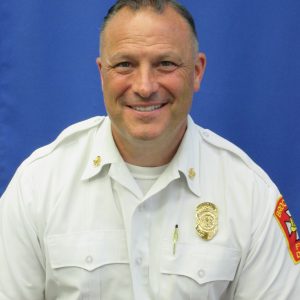The Brockton Fire Department working with the Brockton Police Department, the Massachusetts State Police Fire and Explosion Investigation Unit and the Insurance Fraud Bureau actively investigates motor vehicle fires that occur in the city.
The following is the text of Massachusetts General Law 266 29 B; Burning motor vehicle; owner’s statement to fire department:
Whenever a motor vehicle is burned, the owner of record of such vehicle shall submit to the appropriate fire department a statement signed under the penalties of perjury containing such information concerning the burning of such vehicle as the state fire marshall shall require.
In order to comply with this law, the registered owner of a burned motor vehicle must report in person at the Brockton Fire Prevention Office located at 52 Pleasant Street. Once there the forms must be filled out by the registered owner of the vehicle and signed under the pains and penalties of perjury. A fire department investigator will review the forms with the owner before acceptance.
You are required to bring the following items with you when reporting for your a scheduled appointment to fill out the forms:
- Stolen Car Report (if stolen)
- Recovered Car Report (if stolen)
- Title
- Car Registration – If burned you may obtain a duplicate from the RMV
- Loan Papers
- Bill of Sale
- Repair Records (invoices, receipts & bills)
- Computer printout from last inspection - If burned you may obtain a duplicate from the inspection station that conducted the inspection
- All Keys for the vehicle
- Insurance Policy (front page)
- Insurance claim number
- Drivers license of vehicle owner
- Cell Phone Records for a one day period before and after the fire
- Copy of insurance loss affidavit that you filled out for your insurance company
Once you have gathered all this information please call 508-583-2933 to schedule an appointment with an investigator. Please note that this process will take between 1 and 2 hours to complete.
Secured Key Access System
To allow the Brockton Fire Department the ability to gain rapid access without causing damage, the Brockton Fire Department has instituted a voluntary Secured Key Access System, and is requesting your participation in this program. This system focuses on a high security key safe used to store building access keys for Fire Department use. The key safe is purchased by the building owner and is mounted on the outside of the building adjacent to the access door that would normally be used by the Fire Department to reach the fire alarm system, sprinkler systems, etc. This unit makes keys available to the Fire Department and simultaneously provides you with the security that is important to all our businesses. Only the Fire Department controls access to the lock boxes and therefore eliminates the need to carry hundreds of keys. Should there be an emergency alarm from your building, the Fire Department will be able to gain rapid access, handle the emergency and lock your building to maintain security.
Follow these directions to Order an Approved Locking Device:
- Go to www.knoxbox.com.
- Click on green shopping cart button and find the Brockton Fire Department.
- Select Product for purchase.
- Enter Installation Address.
- Proceed with checkout or an approval request.
A confirmation of order will be sent to the Fire Department. Once the product is received, contact the Fire Prevention Bureau at 508-583-2933 for location approval and lock up.
Fill out and return the following forms to:
Brockton Fire Department
Office of the Fire Chief
560 West Street
Brockton, MA 02301
Secured Key Access System Requirements Secured Key Access Permission and Release
Emergency Contact Form
PLEASE NOTE: The Brockton Fire Department will be the only key holder to your lock box. Any changes you make regarding keys for your building will require that you contact the Brockton Fire Department to respond to your lock box to open, change keys and secure your lock box. This is done immediately at no charge.
Thank you for your participation in the Secured Key Access System.
Building Numbering Guidelines
Statutory references:
Massachusetts General Law – Section 59: Display of street address number on buildings; use in enhanced 911 service
Every building in the commonwealth, including, but not limited to, dwellings, apartment buildings, condominiums, and business establishments shall have affixed thereto a number representing the address of such building. Said number shall be of a nature and size and shall be situated on the building so that, to the extent practicable, it is visible from the nearest street or road providing vehicular access to such building.
The state 911 department shall cause such number and the address of such building to be entered into the electronic data base for use in enhanced 911 service as defined in section eighteen A of chapter six A.
Revised Ordinances of the City of Brockton Sec. 20-4. – Numbering buildings.
The department of public works shall assign numbers to all buildings erected or fronting on any public or private way in the city, and shall have the power to determine the form, size and material of such numbers. No person shall neglect or refuse to affix to any building owned by him the street number so designated for such building, nor shall any person affix to or suffer to remain on any building owned by him, for more than three (3) days, a street number other than the one designated for such building by the department.
The following is a commonsense approach:
- Six inch numbers are great but do not always fit the décor of the building.
- Numbers should be no less than four inches. The bigger the better.
- Use numbers and do not spell the numbers out. 54 rather than Fifty-four.
- Use block lettering.
- Do not use fancy fonts such as cursive script.
- The numbers must be contrasting. If you have a white background, use black numbers. If you have a dark background use white numbers.
- Best placement is either side of the door above the mid line of the door.
- Avoid placing numbers away from the front door such as above garage doors.
- Put the numbers under lighting, so they will be visible at night.
- If your driveway is long, or your house is set back off the road, post your house number on both sides of a mailbox or sign pole at the end of the driveway near the road.
- If your driveway is long, or your house is set back off the road you should consider address signs. They should be placed about two feet from the driveway in the direction of the house.
- The numbers should not be on the door. This is due to the fact that many people open the door when they are waiting for us, and when the door is open you cannot see the numbers.
- The numbers should not be under the door. Many people like to put their numbers under the door on the stoop. The trouble with this is when it snows, the numbers are not visible.
The line that I have been using for years is, “Make them big enough that a 50 year old emergency worker that wears glasses and forgets them can still see the numbers from the street.”
Make sure shrubbery does not interfere with being able to see numbers.
If there is a mailbox at the street (not common in Brockton):
- Do not use your mailbox as the only means of identification for your house.
- If your mailbox is not in front of your house or near your driveway, emergency responders cannot locate you if you do not have your house number on your house or on a post or sign in your yard above the snow line.
- Remember to mark your mailbox on both sides.
- Numbers on the mailbox door may be great for your mail carrier, but are extremely difficult to see by drivers.
Examples of good and bad numbering:

Good placement next to door.
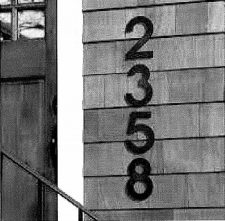
Good placement with Great size numbers.
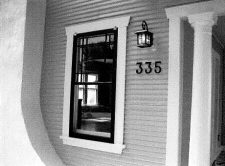
Good placement next to door.

Bad placement on door.
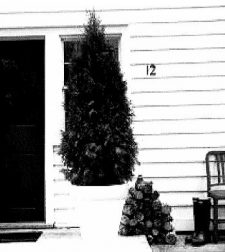
Make sure shrubbery does not interfere with being able to see numbers.
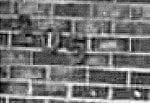
Can you make out the bronze number? If you were looking around, would it catch your eye? Imagine if you stood further away or at night.
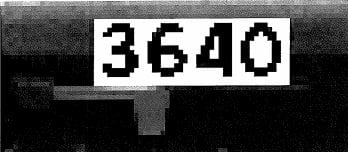
No help. Unfortunately, blank mailboxes like this are everywhere.
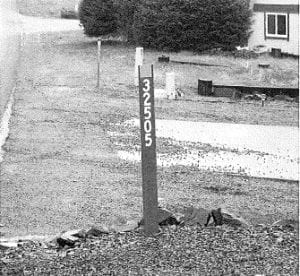
Sample address post.
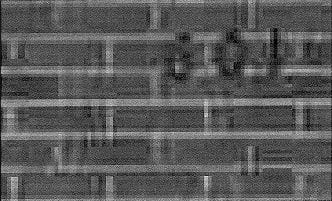
A black number on brick is very hard to see from the road. It needs a white number instead.
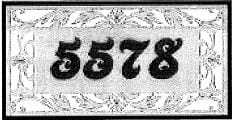
Do not use fancy fonts that are hard to read.
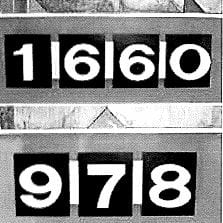
Use plain Block lettering.
Smoke and Carbon Monoxide Detector Inspection Appointments
All appointment should be made at least 20 business days prior to the closing. Don’t wait until the last minute! To schedule an appointment, you or your agent may call the Fire Prevention Office at 508-583-2933 - 24 hours a day. You will either speak to an inspector or leave the appropriate information on the Smoke Detector Scheduling phone. If you leave a message your call will be returned as soon as possible.
Please have the following information available to allow us to serve you better:
- Your Name
- Your phone number
- Address of Inspection
- Number of units in the building
Please speak slowly.
Hours of inspection are between 9:00 AM - 11:00 AM and 1:00 PM - 3:30 PM (on the half-hour) each day and are made on a first-come, first serve basis. One and two family dwellings are normally inspected on Tuesday and Thursdays. Multi Family (above 2 units) and Condo’s are normally inspected on Wednesdays.
The cost of the inspection is as follows:
- One Family $50.00
- Two Family $100.00
- Three to Five Families $150.00
- Six Families and above $500.00
- Re- Inspection (within 30 days) $45.00
Payment is made at the time of the inspection.
Payment shall be made by Bank Check or Money Order only.
Bank Check or Money Order should be made out to the “City of Brockton”.
CASH will not be accepted.
Prior to the arrival of the fire department:
- Make sure that your posted street number is visible from the street (MGL c.148 § 59).
- Make sure that you have the proper type of alarms. The inspector may require that they be taken down for compliance verification.
- Make sure all alarms are installed in the proper locations.
- Make sure that all alarms are working properly.
- Make sure all alarms have not expired. (10 years for smoke alarms – 7 years for CO alarms)
After passing the inspection, the fire department will issue your Certificate of Compliance.
Smoke Alarm and Carbon Monoxide Requirements
as of December 1, 2016
Smoke and Carbon Monoxide Regulations for 1 and 2 family's built prior to 1975
When Selling or Transferring a One- or Two-Family property
The Board of Fire Prevention Regulations (BFPR) adopted revised smoke alarm regulations that go into effect December 1, 2016. The changes apply only to one- and two-family residences built before January 1, 1975 that have not been substantially altered meaning that hardwired electric alarms have been installed. . .If built or altered after that date, the smoke alarm requirements are established by the State Building Code. Working smoke alarms installed prior to December 1, 2016 (that met requirements) can continue to be used until they are 10 years old or have exceeded the manufacturer’s recommended life.
Minimum Requirements for New Smoke Alarms in One- and Two-Family Residences Built before 1975
Smoke alarms must be installed on ceilings and in accordance with the manufacturer’s instructions:
- On every habitable level of the residence.
- In the basement.
- On the ceiling at the base of each stairway leading to a floor above including the basement (but not within stairways).
- On the ceiling outside each separate sleeping area.
- Must be photoelectric. Can be in combination with carbon monoxide alarms.
- Must contain a hush feature to silence nuisance alarms.
- May be battery-powered.
New battery-powered alarms must have 10-year, sealed, nonrechargeable, non-replaceable batteries with a Hush feature.
- Battery-powered alarms that are more than 10 years old, or have expired must be replaced (check with the manufacturer) with 10-year, sealed, non-rechargeable, non-replaceable, battery-powered ones that are Photo Electric and have a hush feature..
- In two-family dwellings, smoke alarms are required in common areas shared by residents. These detectors should be on each level outside the apartment door.
Combination Smoke and Carbon Monoxide Alarms
Combination smoke and carbon monoxide (CO) alarms must follow the requirements for smoke alarms for placement and battery power. However a CO alarm must be within 10 feet of every bedroom door. Combination Smoke and CO must “talk” to you, not just beep.
Assembly Occupancy Egress Locking Guidance
Policy / Standard Number 18
To: Holders of Alcoholic Licenses requiring Fire Department Approval for Certificate of Inspections
From: Fire Prevention Bureau
Re: Locking mechanisms on egress doors.
Inspections have noted a wide variety of locking methods used for egress doors. This document is being distributed to define what this department considers acceptable. We are adopting language and guidance from 780 CMR the State Building Code. The following will outline what the Brockton Fire Department considers as acceptable locking mechanisms on egress doors in your facility.
Egress doors are doors with “EXIT” signs above the doors.
In the past we have noted the use of a “double key cylinder” and “slide bolts”. “Double key cylinders are allowed under certain conditions, but slide bolts are NOT ALLOWED in any case.
780 CMR the state Building code states in part egress from a building via a door must be per IBC 1008.1.9 “…openable from the egress side without the use of a key or special knowledge or effort.”
The above will not allow a key operated lock from the inside.
From the Code Commentary in 1008.1.9.1 Hardware; “Any doors that are located along an accessible route for ingress or egress must have door hardware that is easy to operate by a person with limited mobility. This would include all elements of the door hardware used in typical door operation, such as door levers, locks, security changes, etc. This requirement is also an advantage for persons with arthritis in their hands. Items such as small, full-twist thumb turns or smooth circular knobs are examples of hardware that is not acceptable”.
In your case, section 1008.1.9.3 Locks and latches allows a key operated lock from the egress side your occupancy as long as the occupant load is 300 or less. Should you choose this option there are two signage requirements. One is the locking device is readily distinguishable [2.1] and [2.2] requires visible durable sign stating
“THIS DOOR TO REMAIN UNLOCKED WHEN BUILDING IS OCCUPIED” in 1-inch high letters on the egress side of the door. Most owners will not want this on their doors especially glass doors. Please note that “The use of the key-operated locking device is revocable by the building official for due cause.”
In plain language, egress doors:
- Shall not have a slide bolt, internal or external unless automatically operated;
- Shall not have a double keyed cylinder on any door other than the MAIN door;
- If you choose to have a double keyed cylinder, it may only be used on the MAIN door and the signage outlined above must be present.
Please note that roll down security doors may never be closed or partially closed while the business is open.
Should you have any locking arrangement other than what is allowed, you are hereby ordered to correct these violations immediately and no later than thirty days from the date of this letter. Failure to comply with the Board of Fire Prevention Regulations may result in criminal penalties pursuant to M.G.L. Chapter 148.
Failure to comply with city ordinances may result in civil or criminal penalties as allowed by said ordinances.

